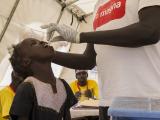Mar 30, 2011 (CIDRAP News) In the wake of a massive egg recall in August 2010, an investigation by the US Department of Agriculture (USDA) into the role of its egg graders recently found that communication breakdowns between producers, the US Food and Drug Administration (FDA), and the egg graders led to problems in another egg recall 3 months later.
The USDA inspector general's office in a Feb 16 report said it was already investigating the earlier egg recall when it found that USDA egg graders unknowingly gave the agency grade mark to most of the eggs from an Ohio producer that were subject to a November 2010 recall for possible Salmonella Enteritidis (SE) contamination.
In August 2010 the recall of over 500 million eggs from two Iowa producers was linked to a nationwide SE outbreak that sickened more than 1,000 people. Investigations into the outbreak exposed not only problems at the farms, but also gaps in egg safety oversight. The USDA is responsible for egg grading, while the FDA handles a host of other egg safety tasks.
At a September 2010 US House of Representatives committee hearing on the egg recall and Salmonella outbreak, several legislators aired their frustration over reports of poor communication between the FDA and UDSA, which they said may have masked ongoing disease threats at the farms.
The focus of the USDA Office of Inspector General (OIG) report, however, was events surrounding a November 2010 FDA recall of shell eggs from Ohio Fresh Eggs in Croton, Ohio. The recall was prompted by SE findings in a routine environmental sample, and no related illnesses were found.
The OIG report said egg producers contract with the USDA's Agricultural Marketing Service (AMS) to certify that eggs meet federal quality standards, and laws prohibit the AMS from putting the grade mark on eggs that are unfit for human consumption, including those adulterated with SE.
OIG auditors found that the AMS grader who put the grade mark on the recalled shell eggs wasn't aware that the Ohio producer had recently had a positive environmental test for SE at one of its barns, because the producer and FDA did not notify the AMS. Graders didn't find out about the positive sample until after the hens were culled and the barn underwent disinfection.
The eggs were shipped for commerce, despite the fact that they were considered adulterated with SE, according to the report. Graders diverted some eggs at the time, because they came through with pink dye on them, which the workers said was staining from a disinfectant used to clean an egg barn.
Investigators learned that AMS contracts with producers don't require producers to notify the AMS of positive tests for SE or other pathogens, and FDA rules don't require plant managers to report positive SE results to either the FDA or AMS, as long as managers take appropriate actions.
The report said the FDA's new shell-egg safety rule, which takes full effect in July 2012, requires egg producers to perform routine SE tests in egg laying barns, but doesn't require them to notify the FDA or AMS when the samples are positive.
During the investigation, AMS officials told the OIG that since 1975 a memorandum of understanding has been in effect that requires the FDA to immediately notify the AMS when egg laying barns test positive for SE. The only evidence the OIG found that the FDA contacted the AMS about the findings was an e-mail that was sent several days after the recall was published.
An AMS grader said some of the adulterated shell eggs from the Ohio producer were slated for processing at a nearby plant, but were mistakenly shipped to an Arkansas packer, where another AMS official graded them in early October, about 2 weeks before the FDA posted its recall.
The OIG concluded that new procedures are needed to prevent AMS graders from unknowingly putting the grading seal on SE-adulterated eggs. "Although the AMS is not directly involved with the prevention of egg adulteration, it can improve its controls when production management has evidence that shell eggs may be adulterated," the OIG report said.
To correct the problems, the OIG suggested that the AMS:
- Notify all shell-egg producers it has contracts with that they are required to immediately let AMS graders know when they learn of possible adulterated eggs at the facility
- Add a requirement to new contracts that producers must immediately notify the AMS when they become aware of a positive test for environmental SE or other contaminants
- Require AMS graders to identify where adulterated eggs were shipped to prohibit them from receiving the USDA grade mark
AMS officials met with the OIG in November to discuss the audit findings. In a Feb 25 letter that accompanied the OIG's audit, AMS Administrator Rayne Pegg wrote that the department agrees in some circumstances that additional controls are needed. She added that since the FDA oversees egg safety, any changes to AMS procedures must be consistent with FDA regulations.
She wrote that the AMS will revise its procedures to require producers to immediately notify AMS graders when a positive environmental sample for SE has been confirmed and what the company plans to do with the eggs. If the company will test the eggs, they need to provide the grader with the details and be prepared to segregate and hold graded eggs until tests clear them for commerce.
The AMS also said it would revise sections of its shell-egg graders handbook to clarify grader and supervisor responsibilities for reporting and controlling contaminated or adulterated shell eggs.
Meanwhile, the OIG said it will continue its audit work on issues relating to the USDA egg grading and its role in egg safety.
See also:
Feb 16 USDA OIG audit and Feb 25 USDA AMS response
Nov 5, 2010, FDA recall notice

















